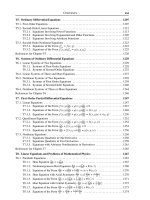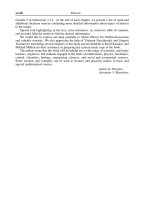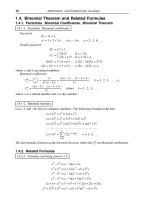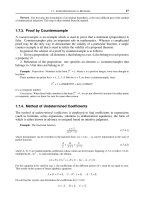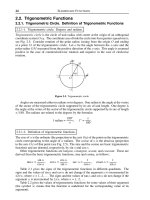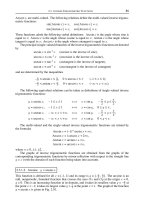Handbook of mathematics for engineers and scienteists part 86 docx
Bạn đang xem bản rút gọn của tài liệu. Xem và tải ngay bản đầy đủ của tài liệu tại đây (402.33 KB, 7 trang )
13.1. LINEAR AND QUASILINEAR EQUATIONS 563
Figure 13.8 illustrates the formation of the shock wave described by the generalized solution of Hopf’s
equation with f(w)=w and generated from a solitary wave with the smooth initial profile (13.1.3.5).
The nonsmooth “step” curves depicted in Fig. 13.8 (for x = 0.15, 0.20,and0.25) are obtained from the
smooth (but many-valued) curves shown in Fig. 13.5 by means of Whitham’s rule of equal areas.
24
6
2.0
1.5
x = 0
0.5 1.0 1.5 2.0 2.5
w
y
Figure 13.8. The formation of a shock wave generated from a solitary wave with the smooth initial profile.
13.1.3-4. Utilization of integral relations for determining generalized solutions.
Generalized solutions which are described by piecewise-smooth (piecewise-continuous)
functions may formally be introduced by considering the following equation written in an
integral form:
–
D
w
∂ψ
∂x
+ F (w)
∂ψ
∂y
dy dx = 0.(13.1.3.9)
Here, D is an arbitrary rectangle in the yx-plane, ψ = ψ(x, y) is any “test” function with
continuous first derivatives in D that is zero at the boundary of D, and the function F (w)
is defined in equation (13.1.3.6). If w and F(w) are continuously differentiable, then
equation (13.1.3.9) is equivalent to the original differential equation (13.1.3.1). Indeed,
multiplying equation (13.1.3.1) by ψ, integrating over the domain D, and then integrating
by parts, we obtain equation (13.1.3.9). Conversely, integrating (13.1.3.9) by parts yields
D
∂w
∂x
+
∂F(w)
∂y
ψdydx= 0.
Since this equation must be satisfied for any test function ψ and since F
(w)=f(w), we
obtain the original equation (13.1.3.1). However, equation (13.1.3.9) has a wider class
of solutions since the admissible functions w(x, y) need not necessarily be differentiable.
The functions w(x, y) satisfying the integral relation (13.1.3.9) for all test functions ψ are
referred to as generalized (or weak) solutions of equation (13.1.3.1).
The use of generalized solutions is convenient for the description of discontinuities,
since it permits one to obtain jump conditions automatically. Consider a solution of equa-
tion (13.1.3.9) continuously differentiable in two portions D
1
and D
2
of the rectangle D,
which has a jump discontinuity at the interface Γ between D
1
and D
2
. Integrating equa-
tion (13.1.3.9) by parts in each of the subdomains D
1
and D
2
yields
D
1
∂w
∂x
+
∂F(w)
∂y
ψdydx+
D
2
∂w
∂x
+
∂F(w)
∂y
ψdydx+
Γ
[w] dy –[F (w)] dx
ψ = 0,
where [w]=w
2
– w
1
and [F (w)] = F (w
2
)–F (w
1
)arejumpsofw and F (w) across Γ.The
curvilinear integral over Γ is formed by the boundary terms of the integrals over D
1
and D
2
that result from the integration by parts. Since the relation obtained must be valid for all
564 FIRST-ORDER PARTIAL DIFFERENTIAL EQUATIONS
test functions ψ, it follows that equation (13.1.3.1) is valid inside each of the subdomains
D
1
and D
2
and, moreover, the relation
[w] dy –[F (w)] dx = 0 (on Γ)
must hold. Assuming as before that the line of discontinuity is defined by the equation
y = s(x), we arrive at the jump condition (13.1.3.6).
It is worth noting that condition (13.1.3.7) does not follow from the integral rela-
tion (13.1.3.9) but is deduced from the additional condition of stability of the solution.
13.1.3-5. Conservation laws. Viscosity solutions.
Point out also other ways of introducing generalized solutions.
1
◦
. Generalized solution may be introduced using the conservation law
d
dx
y
2
y
1
wdy+ F (w
2
)–F (w
1
)=0,(13.1.3.10)
where w = w(x, y)andw
n
= w(x, y
n
)(n = 1, 2). Just as in equation (13.1.3.6), the
function F (w)isdefined as F (w)=
f(w) dw. Relation (13.1.3.10) is assumed to hold
for any y
1
and y
2
. It has a simple physical interpretation: the rate of change of the total
value of w distributed over the interval (y
1
, y
2
) is compensated for by the “flux” of the
function F (w) through the endpoints of the interval.
Let w be a continuously differentiable solution of the conservation law. Then, dif-
ferentiating equation (13.1.3.10) with respect to y
2
and setting y
2
= y, we arrive at equa-
tion (13.1.3.1). The conservation law (13.1.3.10) is convenient for the reason that is
admits discontinuous solutions. It is not difficult to show that in this case the jump condi-
tion (13.1.3.6) must hold. For this reason, conservation laws like (13.1.3.10) are sometimes
used as the basis for determining generalized solutions.
2
◦
. An alternative approach to determining generalized solutions involves the consideration
of an auxiliary equation of the parabolic type of the form
∂w
∂x
+ f (w)
∂w
∂y
= ε
∂
2
w
∂x
2
, ε > 0.(13.1.3.11)
The generalized solution of the Cauchy problem (13.1.3.1), (13.1.3.2) (for a finite initial
profile) is defined as the limit of the solution of equation (13.1.3.11) with the same initial
condition (13.1.3.2) as ε → 0. It is shown by Oleinik (1957) and Gelfand (1959) that the
above definitions of the generalized solution leads to the same results.
The parameter ε plays the role of “viscosity” (by analogy with the viscosity of a fluid),
which “smooths out” the jump, thus making the profile of the unknown w continuous.
Therefore, the above construction, based on proceeding to the limit as ε → 0, is called
the method of vanishing viscosity and the limit function obtained is called the viscosity
solution. Equation (13.1.3.11) with small ε is not infrequently used as a basis for numerical
simulation of discontinuous solutions of equation (13.1.3.1); in this case, one need not
specially separate in the numerical scheme a domain of discontinuity.
Remark. In specific problems, first-order quasilinear equations are often a consequence of integral con-
servation laws, having clear physical interpretation. In such cases, one should introduce generalized solutions
on the basis of these conservation laws; for example, see Whitham (1974) and Rozhdestvenskii and Yanenko
(1983). The thus obtained nonsmooth generalized solutions may differ from those described above.
13.1. LINEAR AND QUASILINEAR EQUATIONS 565
13.1.3-6. Hopf’s formula for the generalized solution.
Below we give a general formula for a generalized solution of the Cauchy problem
(13.1.3.1), (13.1.3.2), describing discontinuous solutions that satisfy the stability condi-
tion (13.1.3.7). As above, we assume that x ≥ 0 and f > 0 for w > 0; f
w
> 0.
Consider the function
Z(s)=min
w
ws – F (w)
,whereF (w)=
f(w) dw.(13.1.3.12)
We set
H(x, y, η)=
η
0
ϕ(¯η) d¯η + xZ
y – η
x
.(13.1.3.13)
This is a continuous function of η for fixed x and y. It can be shown that for fixed x and with
the exception of a countable set of values of y, function (13.1.3.13) has a unique minimum
with respect to η. Denote the position of this minimum by η = ξ,whereξ = ξ(x, y). The
stable generalized solution of equation (13.1.3.1) subject to the initial condition (13.1.3.2)
is given by
w(x, y)=Z
y – ξ
x
,whereZ(s)=
dZ
ds
.(13.1.3.14)
The function Z = Z(s)defined by relation (13.1.3.12) can be represented in the para-
metric form
s = f(w), Z = ws –
f(w) dw.(13.1.3.15)
Hence follows the parametric representation for its derivative Z = Z(s):
s = f(w), Z = w.(13.1.3.16)
The position of the minimum η = ξ(x, y) of function (13.1.3.13) is determined by the
condition H
η
= 0, which results in the following equation for ξ:
ϕ(ξ)–Z
y – ξ
x
= 0.(13.1.3.17)
To illustrate the utilization of the above formulas, we consider two cases.
1
◦
. Let the algebraic (or transcendental) equation (13.1.3.17) have a unique solution ξ =
ξ(x, y) in some domain of the xy-plane. We set s=(y–ξ)/x in (13.1.3.16) and consider these
relations in conjunction with equation (13.1.3.17). Eliminating the functions f(w)andZ
from these equations yields a solution of the problem in the parametric form (13.1.3.3). In
this case, we obtain a smooth (classical) solution describing a rarefaction wave.
2
◦
. Let the algebraic (or transcendental) equation (13.1.3.17) have two different solutions,
ξ
1
and ξ
2
, that are functions of x and y. For both cases, solution (13.1.3.3) is valid, where
either ξ = ξ
1
or ξ = ξ
2
. At each point (x, y), we choose that solution ξ
n
(n = 1, 2)which
minimizes the function H(x, y, ξ
n
)defined by equation (13.1.3.13). In this case, we obtain
a discontinuous (generalized) solution describing a shock wave.
566 FIRST-ORDER PARTIAL DIFFERENTIAL EQUATIONS
13.1.3-7. Problem of propagation of a signal.
In the problem of propagation of a signal and other physical applications, one seeks a
solution of equation (13.1.3.1) subject to the conditions
w = w
0
at x = 0 (initial condition),
w = g(x)aty = 0 (boundary condition),
(13.1.3.18)
where w
0
is some constant and g(x) is a prescribed function. One considers the domain
x > 0, y > 0,wherex plays the role of time and y the role of the spatial coordinate. It is
assumed that f(w)>0.
The characteristics of this problem issue from the positive semiaxis y and the positive
semiaxis x (see Fig. 13.9). We have w = w
0
at the characteristics issuing from the y-axis.
Hence, these characteristics are straight lines defined by y – a
0
x = const, where a
0
= f(w
0
).
It follows that
w = w
0
for y > a
0
x.(13.1.3.19)
As far as the characteristics issuing from the x-axis are concerned, we assume that one
of the characteristics starts from a point x = τ . The solution of equation (13.1.3.1) subject
to conditions (13.1.3.18) can be represented in the parametric form
y = G(τ)(x – τ), w = g(τ), (13.1.3.20)
where G(τ)=f
g(τ)
. This solution can be related to solution (13.1.3.3) of the Cauchy
problem (13.1.3.1), (13.1.3.2) by setting
ξ =–τG(τ), ϕ(ξ)=g(τ), F(ξ)=G(τ). (13.1.3.21)
This corresponds to the continuation of characteristics through the points y = 0, x = τ to
the y-axis and to the designation of the points of intersection by y = ξ. In this case, the
problem of propagation of a signal is formulated as a Cauchy problem.
yww=
0
x
y = x
x = t
line of discontinuity
characteristics
Figure 13.9. Characteristics of the problem of propagation of a signal.
Each domain of nonuniqueness in solution (13.1.3.20) should be replaced by a jump
discontinuity. If
G(+0)>a
0
,wherea
0
= f (w
0
),
13.1. LINEAR AND QUASILINEAR EQUATIONS 567
such a domain arises instantaneously, since the first characteristic y = G(+0)x is ahead of
the last characteristic y = a
0
x of the unperturbed domain. In this case, the discontinuity
appears at the origin of coordinates and the relation
G – G
0
=(w – w
0
)G –
1
x – τ
τ
0
G(¯τ)–G
0
d¯τ (13.1.3.22)
holds. The quantities w, G,andG are functions of τ in the domain behind the discontinuity
andaregivenby
w = g(τ), G = f
g(τ)
, G = F
g(τ)
.
The subscript 0 refers to the values of these variables ahead of the discontinuity, w = w
0
,
G
0
= f (w
0
), and G
0
= F (w
0
).
Relations (13.1.3.20) describe the solution in the perturbed domain behind the disconti-
nuity. Equation (13.1.3.22) serves to determine τ (x) at the point of discontinuity; by setting
this value into relations (13.1.3.20), we find both the position of the discontinuity and the
value of w immediately behind it.
If g(x) remains constant and equal to w
c
, then for a
c
> a
0
,wherea
c
= f (w
c
), the
solution has a jump discontinuity propagating at a constant velocity and separating two
homogeneous domains with w = w
c
and w = w
0
.
13.1.4. Quasilinear Equations of General Form. Generalized
Solution, Jump Condition, and Stability Condition
13.1.4-1. Quasilinear equations in conservative form.
In the general case, the quasilinear equation
∂w
∂x
+ f(x, y, w)
∂w
∂y
= g(x, y, w)(13.1.4.1)
can be represented in an equivalent, conservative form as
∂w
∂x
+
∂
∂y
F (x, y, w)=G(x, y, w), (13.1.4.2)
where
F (x, y, w)=
w
w
0
f(x, y, t) dt, G(x, y, w)=g(x, y, w)+
w
w
0
∂
∂y
f(x, y, t)
dt,(13.1.4.3)
and w
0
is an arbitrary number. In what follows we assume that the functions f and g are
continuous and have continuous first derivatives.
As was shown by examples in Subsections 13.1.2 and 13.1.3, characteristics of equa-
tion (13.1.4.1) can intersect in some domain, which results in the nonuniqueness of the
solution and the absence of a physical interpretation of this solution. For this reason, one
has to make use of a generalized solution, described by a discontinuous function instead of
a classical smooth solution.
We consider the class of functions w(x, y)
K satisfying the following conditions:
1
◦
. In any bounded portion of the half-plane x ≥ 0, there exists a finite number of lines and
points of discontinuity; outside these lines and points, the function w(x, y) is continuous
and has continuous first derivatives.
2
◦
. At the lines of discontinuity, y = y(x), the left and right limit values of w exist: w(x, y–0)
and w(x, y + 0).
568 FIRST-ORDER PARTIAL DIFFERENTIAL EQUATIONS
13.1.4-2. Generalized solution. Jump condition and stability condition.
A generalized solution may be introduced in the following manner. Let ψ(x, y) C
1
be a
continuous finite function (which vanishes outside a finite portion of the xy-plane) having
continuous first derivatives.
Multiply equation (13.1.4.1) by ψ(x, y) and integrate the resulting relation over the
half-plane Ω = {0 ≤ x < ∞,–∞ < y < ∞}. On integrating by parts, we obtain
Ω
w
∂ψ
∂x
+ F(x, y, w)
∂ψ
∂y
+ G(x, y, w)ψ(x, y)
dy dx +
∞
–∞
w(0, y)ψ(0, y) dy = 0.
(13.1.4.4)
The function F (x, y, w)isdefined in equation (13.1.4.3). The integral relation (13.1.4.4)
does not contain derivatives of the unknown function and does not lose its meaning for
discontinuous w(x, y). The function w(x, y)
K will be called the generalized solution of
equation (13.1.4.1) if inequalities (13.1.4.4) hold for any finite ψ(x, y) C
1
.
Basic properties of the stable generalized solution:
1
◦
. In the domain where the solution w is continuously differentiable, equations (13.1.4.1)
and (13.1.4.4) are equivalent.
2
◦
.Lety = y(x) be the equation of a discontinuity line of w(x, y). Then the Rankine–
Hugoniot jump condition must hold. It expresses the speed of motion of the discontinuity
line via the solution parameters ahead of and behind the discontinuity as
V =
[F (x, y, w)]
[w]
≡
F
x, y(x), w
2
(x)
– F
x, y(x), w
1
(x)
w
2
(x)–w
1
(x)
,(13.1.4.5)
where
V = y
(x), w
1
(x)=w
x, y(x)–0
, w
2
(x)=w
x, y(x)+0
.
3
◦
.Forf
w
(x, y, w) ≠ 0, the generalized solution stable with respect to small perturbations
of the initial profile (it is stable solutions that are physically realizable) must satisfy the
condition
f
x, y(x), w
2
(x)
≤ V ≤ f
x, y(x), w
1
(x)
.(13.1.4.6)
The stability condition (13.1.4.6) has the geometrical meaning that the characteristics issu-
ing from the x-axis (these characteristics “carry” information about the initial data) must
intersect the discontinuity line (see Fig. 13.7). This condition is very important since it
allows for the existence of a stable generalized solution and provides its uniqueness.
The properties of Items 1
◦
and 2
◦
follow from the integral relation (13.1.4.4), and the
condition of Item 3
◦
is additional [it cannot be deduced from the integral relation (13.1.4.4)].
If the stability condition of Item 3
◦
is not imposed, then various generalized solutions
satisfying Items 1
◦
and 2
◦
may be constructed.
Example 4. Consider the Cauchy problem for equation (13.1.2.8) with the initial condition (13.1.2.15).
We set
w(x,y)=
w
1
for y < Vx,
w
2
for y > Vx,
where V =
w
1
+ w
2
2
.(13.1.4.7)
This function is constant from the left and right of the discontinuity line y = Vx, where the jump condi-
tion (13.1.4.5) is met [since F (x, y,w)=
1
2
w
2
], and satisfies the initial condition (13.1.2.15). Hence, w is a
generalized solution.
Figure 13.10 shows the discontinuity line and characteristics corresponding to solution (13.1.4.7). One
can see that the characteristics “issue” from the discontinuity line and do not intersect the x-axis. Therefore,
solution (13.1.4.7) is unstable, does not satisfy condition (13.1.4.6), and is not physically realizable. A stable
solution of this problem was constructed earlier; see relation (13.1.2.18).
13.1. LINEAR AND QUASILINEAR EQUATIONS 569
1
30
24
1
3
x
y
w
1
= 0.2
w
2
= 2.0
Figure 13.10. Characteristics and the discontinuity line for an unstable discontinuous solution (13.1.4.7).
If f
w
(x, y, w) is not a function of fixed sign, the stability condition for the generalized
solution becomes more complicated:
F (x, y, w
∗
)–F (x, y, w
2
)
w
∗
– w
2
≤ V ≤
F (x, y, w
∗
)–F (x, y, w
1
)
w
∗
– w
1
,
y = y(x), w
1
< w
∗
< w
2
,
where w
∗
is any value from the interval (w
1
, w
2
).
Remark. Point out also other ways of defining generalized solutions (using conservation laws and viscosity
solutions).
13.1.4-3. Method for constructing stable generalized solutions.
Consider the Cauchy problem for the quasilinear equation
∂w
∂x
+
∂
∂y
F (x, y, w)=0 (13.1.4.8)
subject to the initial condition
w = ϕ(y)atx = 0.(13.1.4.9)
It is assumed that the function F (x, y, w) is continuously differentiable with respect to all
its arguments for x ≥ 0,–∞ < y < ∞ and any bounded w. We also assume that the second
derivative F
ww
is positive. Let the functions ϕ(y)andϕ
(y) be piecewise-continuous for
any finite y.
The characteristic system for equation (13.1.4.8) has the form
y
x
= F
w
(x, y, w), w
x
=–F
y
(x, y, w), (13.1.4.10)
where F
w
and F
y
are the partial derivatives of the function F with respect to w and y.
Suppose the functions
y(x)=Y (x, τ, ξ, η), w(x)=W (x, τ , ξ, η)(13.1.4.11)
are solutions of system (13.1.4.10) satisfying the boundary conditions
y(0)=η, y(τ)=ξ.(13.1.4.12)



